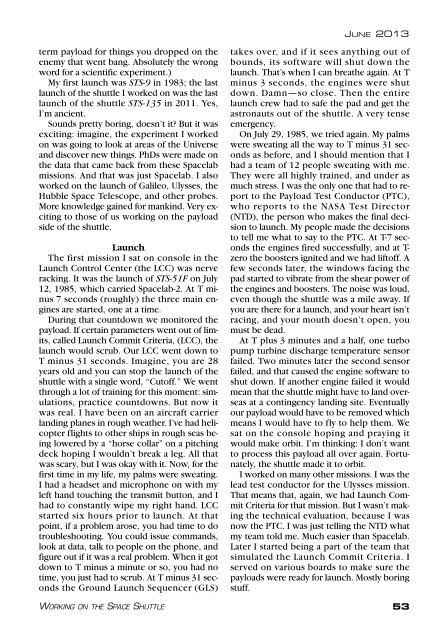Analog Science Fiction and Fact - June 2013
Analog Science Fiction and Fact - June 2013
Analog Science Fiction and Fact - June 2013
You also want an ePaper? Increase the reach of your titles
YUMPU automatically turns print PDFs into web optimized ePapers that Google loves.
term payload for things you dropped on the<br />
enemy that went bang. Absolutely the wrong<br />
word for a scientific experiment.)<br />
My first launch was STS-9 in 1983; the last<br />
launch of the shuttle I worked on was the last<br />
launch of the shuttle STS-135 in 2011. Yes,<br />
I’m ancient.<br />
Sounds pretty boring, doesn’t it? But it was<br />
exciting: imagine, the experiment I worked<br />
on was going to look at areas of the Universe<br />
<strong>and</strong> discover new things. PhDs were made on<br />
the data that came back from these Spacelab<br />
missions. And that was just Spacelab. I also<br />
worked on the launch of Galileo, Ulysses, the<br />
Hubble Space Telescope, <strong>and</strong> other probes.<br />
More knowledge gained for mankind. Very exciting<br />
to those of us working on the payload<br />
side of the shuttle.<br />
Launch<br />
The first mission I sat on console in the<br />
Launch Control Center (the LCC) was nerve<br />
racking. It was the launch of STS-51F on July<br />
12, 1985, which carried Spacelab-2. At T minus<br />
7 seconds (roughly) the three main engines<br />
are started, one at a time.<br />
During that countdown we monitored the<br />
payload. If certain parameters went out of limits,<br />
called Launch Commit Criteria, (LCC), the<br />
launch would scrub. Our LCC went down to<br />
T minus 31 seconds. Imagine, you are 28<br />
years old <strong>and</strong> you can stop the launch of the<br />
shuttle with a single word, “Cutoff.” We went<br />
through a lot of training for this moment: simulations,<br />
practice countdowns. But now it<br />
was real. I have been on an aircraft carrier<br />
l<strong>and</strong>ing planes in rough weather. I’ve had helicopter<br />
flights to other ships in rough seas being<br />
lowered by a “horse collar” on a pitching<br />
deck hoping I wouldn’t break a leg. All that<br />
was scary, but I was okay with it. Now, for the<br />
first time in my life, my palms were sweating.<br />
I had a headset <strong>and</strong> microphone on with my<br />
left h<strong>and</strong> touching the transmit button, <strong>and</strong> I<br />
had to constantly wipe my right h<strong>and</strong>. LCC<br />
started six hours prior to launch. At that<br />
point, if a problem arose, you had time to do<br />
troubleshooting. You could issue comm<strong>and</strong>s,<br />
look at data, talk to people on the phone, <strong>and</strong><br />
figure out if it was a real problem. When it got<br />
down to T minus a minute or so, you had no<br />
time, you just had to scrub. At T minus 31 seconds<br />
the Ground Launch Sequencer (GLS)<br />
WORKING ON THE SPACE SHUTTLE<br />
JUNE <strong>2013</strong><br />
takes over, <strong>and</strong> if it sees anything out of<br />
bounds, its software will shut down the<br />
launch. That’s when I can breathe again. At T<br />
minus 3 seconds, the engines were shut<br />
down. Damn—so close. Then the entire<br />
launch crew had to safe the pad <strong>and</strong> get the<br />
astronauts out of the shuttle. A very tense<br />
emergency.<br />
On July 29, 1985, we tried again. My palms<br />
were sweating all the way to T minus 31 seconds<br />
as before, <strong>and</strong> I should mention that I<br />
had a team of 12 people sweating with me.<br />
They were all highly trained, <strong>and</strong> under as<br />
much stress. I was the only one that had to report<br />
to the Payload Test Conductor (PTC),<br />
who reports to the NASA Test Director<br />
(NTD), the person who makes the final decision<br />
to launch. My people made the decisions<br />
to tell me what to say to the PTC. At T-7 seconds<br />
the engines fired successfully, <strong>and</strong> at Tzero<br />
the boosters ignited <strong>and</strong> we had liftoff. A<br />
few seconds later, the windows facing the<br />
pad started to vibrate from the shear power of<br />
the engines <strong>and</strong> boosters. The noise was loud,<br />
even though the shuttle was a mile away. If<br />
you are there for a launch, <strong>and</strong> your heart isn’t<br />
racing, <strong>and</strong> your mouth doesn’t open, you<br />
must be dead.<br />
At T plus 3 minutes <strong>and</strong> a half, one turbo<br />
pump turbine discharge temperature sensor<br />
failed. Two minutes later the second sensor<br />
failed, <strong>and</strong> that caused the engine software to<br />
shut down. If another engine failed it would<br />
mean that the shuttle might have to l<strong>and</strong> overseas<br />
at a contingency l<strong>and</strong>ing site. Eventually<br />
our payload would have to be removed which<br />
means I would have to fly to help them. We<br />
sat on the console hoping <strong>and</strong> praying it<br />
would make orbit. I’m thinking: I don’t want<br />
to process this payload all over again. Fortunately,<br />
the shuttle made it to orbit.<br />
I worked on many other missions. I was the<br />
lead test conductor for the Ulysses mission.<br />
That means that, again, we had Launch Commit<br />
Criteria for that mission. But I wasn’t making<br />
the technical evaluation, because I was<br />
now the PTC. I was just telling the NTD what<br />
my team told me. Much easier than Spacelab.<br />
Later I started being a part of the team that<br />
simulated the Launch Commit Criteria. I<br />
served on various boards to make sure the<br />
payloads were ready for launch. Mostly boring<br />
stuff.<br />
53

















